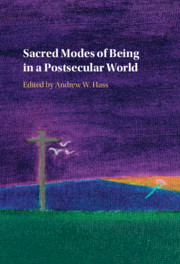Book contents
- Sacred Modes of Being in a Postsecular World
- Reviews
- Sacred Modes of Being in a Postsecular World
- Copyright page
- Contents
- Figures
- Contributors
- Acknowledgements
- Introduction
- Part I Jasper’s Sacred Mode of Being
- Part II Theology’s Cultural Mode of the Sacred
- Chapter 4 Theology as Literature, Rhetoric and Ideology
- Chapter 5 Hope in the Sacred Community
- Chapter 6 The Advent of the Nothing
- Part III Culture’s Theological Mode of the Sacred
- Bibliography
- Index
Chapter 4 - Theology as Literature, Rhetoric and Ideology
from Part II - Theology’s Cultural Mode of the Sacred
Published online by Cambridge University Press: 07 September 2021
- Sacred Modes of Being in a Postsecular World
- Reviews
- Sacred Modes of Being in a Postsecular World
- Copyright page
- Contents
- Figures
- Contributors
- Acknowledgements
- Introduction
- Part I Jasper’s Sacred Mode of Being
- Part II Theology’s Cultural Mode of the Sacred
- Chapter 4 Theology as Literature, Rhetoric and Ideology
- Chapter 5 Hope in the Sacred Community
- Chapter 6 The Advent of the Nothing
- Part III Culture’s Theological Mode of the Sacred
- Bibliography
- Index
Summary
This chapter explores Christian theology’s relationship to the literary and the rhetorical to demonstrate the shifts that theology and biblical studies have made in light of David Jasper’s lament that they have “never really accepted the need” to come to terms with postmodern reflections on textuality.It does so through examining an underlying rhythm, vibration or attunement that Christian theology, literature and rhetoric share, one characterized as kenotic. The appeal to the primordiality of rhythm is well documented in postmodern philosophy, following in the wake of Nietzsche. It has surfaced as a theological category in the work of Erich Pryzwara, and the publication of Raimon Panikkar’s Gifford Lectures. The analysis begins with remarks from Roberto Calasso on rhythm and form in, and as, defining literature. It then explores the ‘kenotic’ nature of the operation of imagination. Some of the most important Christian theologians of the past were trained in rhetoric, and so in examining the imagination in both theological and the literary production, the chapter turns to why rhetoric is important for theological discourse, despite the dangers of ideological persuasion.
- Type
- Chapter
- Information
- Sacred Modes of Being in a Postsecular World , pp. 87 - 111Publisher: Cambridge University PressPrint publication year: 2021

